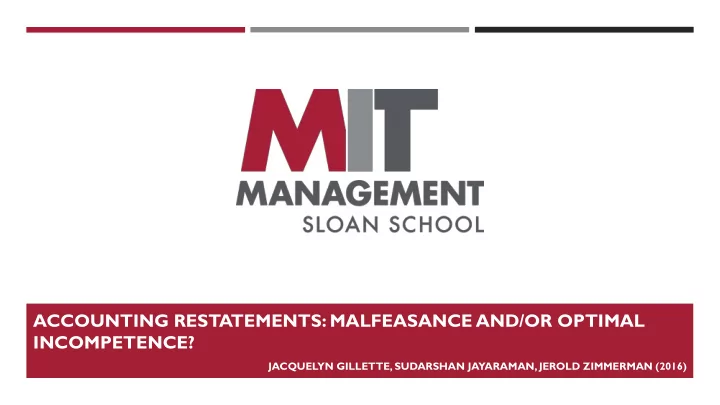

ACCOUNTING RESTATEMENTS: MALFEASANCE AND/OR OPTIMAL INCOMPETENCE? JACQUELYN GILLETTE, SUDARSHAN JAYARAMAN, JEROLD ZIMMERMAN (2016)
RESEARCH QUESTION Is the level of earnings quality driven by managers’ optimal investment in accounting resources, absent managerial malfeasance?
MOTIVATION Large number of studies on the determinants of earnings quality (EQ) (Dechow et al., 2010). Recognize that EQ is driven by innate and discretionary factors (e.g., Dechow and Dichev, 2002; Francis et al., 2005). Innate factors (e.g., firm size) capture the difficulty of estimating accruals in uncertain operating environments.
CONTRIBUTION Build on prior studies to suggest another mechanism for why innate factors are correlated with EQ through firms’ investment in accounting resources. Investment in accounting resources : Long-term investments in accounting hardware, software, and human capital. Ceteris paribus , smaller investments in accounting resources will lead to: 1 . Less accurate accrual estimates 2 . More mistakes 3 . Higher incentives to misrepresent firm performance
OBJECTIVES Theoretical Framework : Develop a framework where restatements (proxy for EQ) are a function of both: ( 1 ) Optimal investment in accounting resources “Optimal incompetence” ( 2 ) Incentives to intentionally misrepresent the firm’s financial performance “Malfeasance”
OBJECTIVES Empirical Measures : Provide two measures for investment in accounting resources: (1) 10K Filing Timeliness (2) 10K Spelling Errors Test whether investment in accounting resources determines EQ (predicts restatements).
MAIN FINDINGS The firm’s investment in accounting resources determines earnings quality (EQ). ( 1 ) Measures of accounting resources are significantly correlated with innate factors (e.g., firm size and profitability). ( 2 ) Accounting resources are negatively associated with the likelihood of a restatement in the subsequent year. Additional Analyses: Accounting resources better predict future restatements during booms in the business cycle. Robust to controlling for endogeneity using an IV design that exploits changes in firms’ filing deadlines.
MODEL INTUITION Smaller, financially weaker firms will optimally invest less in accounting resources. Why? Accounting resources are long-run investments that provide benefits over a long period of time. Smaller, less profitable firms have shorter horizons and receive smaller benefits to these investments. (1) More likely to be acquired (2) More likely to file for bankruptcy (abandonment option) Investing less in accounting resources will lead to lower EQ ( ex post ): More spelling mistakes Less timely 10-K filings More accounting restatements
EMPIRICAL DESIGN = = α + β + β + β + β + β Pr RESTATE 1 ACC _ RES ROA RET NCAP LEV + i t , 1 0 1 i t , 2 i t , 3 i t , 4 i t , 5 i t , ∑ + β + β + β + β + SGR RETVOL SIZE SIZE _ SQ Ind (14) 6 i t , 7 i t , 8 i t , 9 i t , i i ∑ + + ε Year + t i t . 1 t
TABLE 1: DATA & SAMPLE SELECTION
TABLE 2: DESCRIPTIVE STATISTICS
TABLE 4: RESTATEMENT PREDICTION MODEL WITH ACCOUNTING RESOURCES
TABLE 5: RULING OUT AUDIT VERIFICATION EFFECTS
TABLE 6: ADDRESSING ENDOGENEITY OF ACCOUNTING RESOURCES
TABLE 7: FILING TIMELINESS & RESTATEMENTS ACROSS THE BUSINESS CYCLE
TABLE 7: FILING TIMELINESS & RESTATEMENTS ACROSS THE BUSINESS CYCLE
TABLE 8: ACCOUNTING RESOURCES BY RESTATEMENT TYPE
CONCLUSION We provide a theoretical and empirical model where the investment in accounting resources depends on size and profitability. Introduce two novel measures for accounting resources (10K filing timeliness and spelling errors). Accounting resources predicts future restatements. Firms optimally invest in accounting resources, and the level of this investment drives earnings quality (EQ).
THANK YOU. JGILLETT@MIT.EDU
APPENDIX
RESTATEMENT MODEL R t = v 0 + v 1 SIZE t-1 + v 2 ROA t-1 + v 3 MTB t-1 + v 4 LEV t-1 + v 5 NCAP t-1 + v 6 GROW t-1 + v 7 INCENT t-1 (1) R t = e 0 + e 1 ACC_RES t-1 + e 2 INCENT t-1 (6) ACC_RES t = a 0 + a 1 SIZE t + a 2 ROA t + a 3 CMPLX t + a 4 GROW t (2) INCENT t = d 0 + d 1 ACC_RES t + d 2 ROA + d 3 NCAP t + d 4 LEV t + d 5 MTB t + d 6 GROW t (5)
RESTATEMENT MODEL FILE_TIME t = b 0 + b 1 ACC_RES t (3) SPELL_ERR t = c 0 + c 1 ACC_RES t (4) R t+1 = g 0 + g 1 FILE_TIME t + g 2 SPELL_ERR t + g 3 ROA t + g 4 NCAP t + g 5 LEV t + g 6 MTB t + g 7 GROW t (13) FILE_TIME : The difference between the firm’s filing deadline date and the date the firm filed its 10K. SPELL_ERR : The number of spelling errors in the 10K.
Recommend
More recommend